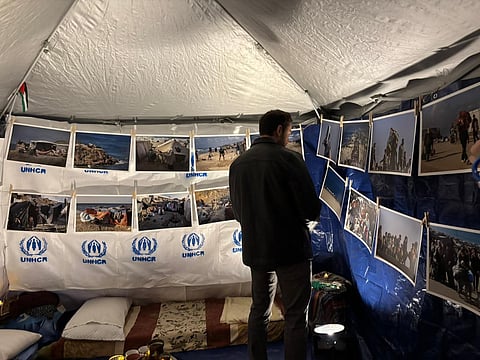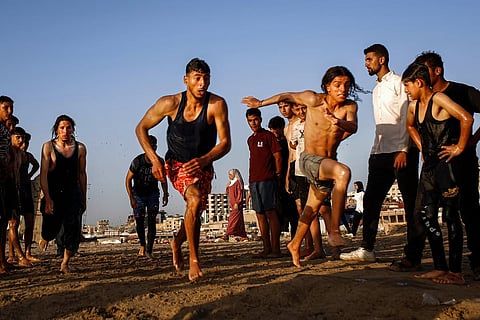Marking two years of Israel's war on Gaza, Outlook revisits tales of courage, loss and endurance from Palestine, bearing witness, lest the people behind the names are forgotten.
The Silenced Storytellers Of Gaza
Artist Frans O. Al-Salmi and photojournalist Ismail Abu Hatab, through their art and photographs, were sharing the misery of Gaza with the world, until their lives were cut short by Israeli airstrikes June 30
“Creating art amid genocide is unbearable. You feel like every photo you take might be your last. You carry in your heart the screams of those not yet buried. And yet, one continues creating because silence is betrayal.”
When all else fails and cries for justice fall on deaf ears, angst takes the shape of art. It takes courage for stifled voices and vulnerable lives amidst war to be heard—and greater courage to document or turn their truth into art. Man was given a tongue to speak and a conscience to feel. Yet, amid the ongoing genocide and the world’s deafening silence on the killing of Palestinians, empathy has become a scarce and fragile resource. On June 30, Al-Baqa Café was targeted by an Israeli airstrike, killing 33 Palestinians. Journalists often gathered at the café to upload footage and file reports documenting Israel’s ongoing genocide.
Embers of hope endure—kept alive by the unwavering legacies of artist Frans O. Al-Salmi and photojournalist Ismail Abu Hatab, whose lives were tragically claimed in the airstrike. It was among the sites targeted by Israeli forces that day, reportedly killing over 70 people in total, including Palestinians in search of humanitarian aid. In a war against truth, art is resistance and political discourse in its rawest form. So is the courage to report it. Abu Hatab and Al-Salmi were part of ByPa, a community co-founded by Abu Hatab himself, that continues to share Palestinian voices through photography, writing, art, music and storytelling.

“We had hoped to meet once the genocide ended, once survival was possible. But death was faster than our dreams,” says Zahra Saeed, a Palestinian journalist and close friend of theirs. She shared that they were children of the same people, divided by checkpoints and siege. They had spent their entire lives under total blockade—by air, land, and sea. Abu Hatab was more than just a photojournalist and Al-Salmi was more than just an artist. They were voices of defiant beauty in a place where mourning is constant, and survival itself becomes a form of resistance. Through their work, both Al-Salmi and Abu Hatab envisioned a future in which Palestinians could live with dignity, possibility, and self-determined joy.
Abu Hatab had previously survived an attack that left him with serious injuries. Despite inadequate medical care and a year of limited mobility, the 32-year-old persisted in making films and photographing Gaza. Ghada A. Hamwi, also a ByPa co-founder, says: “Ismail saw stories in every shattered wall, in the eyes of children, in the dust of dawn over Gaza. Even on crutches, with a body heavy with wounds, he moved with confidence—and with poetry. That’s what I miss the most: their insistence on beauty, even in the heart of collapse.”
The question that sticks out like a sore thumb is whether lives must be sacrificed before efforts are truly recognised. Their lives were taken from them unnaturally and their final works were never meant to be final. Sameera Fazal, a narrator at ByPa, expresses her grief and says: “I was amazed to see how his followers doubled and he got more coverage after his martyrdom. My heart is full of sadness, anger and loss.” Fazal also mentioned that Abu Hatab wanted to evacuate to get treatment for his leg injury due to the massacre that he survived in 2023, but there was a cruel silence from the world.

Al-Salmi’s final work bore the marks of her unshaken spirit—a persistent woman and her refusal to be reduced by war. In her heart-shattering painting, captioned: “The blood of the martyr. Blood scented with cardamom”, she captures the aftermath of losing one’s family and loved ones. The painting presents three figures—one central, wrapped in white and lying still, shielded by two older figures. All appear shrouded in white cloth resembling burial coverings, evoking the imagery of mass funerals in conflict zones. The rough strokes and restricted palette dominated by reds, blacks, and whites intensify the sense of bloodshed, grief, and collective loss. Narrator Fazal says: “It's heartbreaking that her own life ended in a similar tragic way, making her art even more poignant”.
Al-Salmi also produced graphic novel-style panels and caricatures that conveyed dread and devastation with striking clarity. Her use of minimal, often duochrome palettes and coarse textures, intensified the starkness of the suffering. In one of her recent works, she illustrates the horror of an explosion reflected in a Palestinian’s eyes—smoke curling above collapsed buildings as crowds flee with only their families, pets, and the clothes on their backs, while Israeli tanks advance behind them.

On May 15, Al-Salmi posted an image of her artwork marking 77 years since the Nakba. An old man, hunched under the weight of age, memory, and forced displacement, stands holding the keys to a home he was made to abandon. Wrapped in olive branches, he becomes an enduring emblem of loss, resilience, and the unresolved question of return.
Abu Hatab’s photo-exhibition ‘Between Sky and Sea’, whose poster Al-Salmi designed, had already reached international audiences, and his next exhibition, planned for Chicago, was underway when his life was taken. Abu Hatab documented the mass displacement in Gaza—families walking barefoot across broken ground, mothers carrying children and memories. Hamwi reiterates: “Creating art amid genocide is unbearable. You feel like every photo you take might be your last. You carry in your heart the screams of those not yet buried. And yet, we continue creating because silence is betrayal.”

Though they both did not live to see their dreams realised, their vision remains. Journalist Saeed also shared that a promise was made—to them and their families—that they would not be reduced to mere statistics. Their deaths would not be in vain; their names would endure, and their work would be remembered.
From the Palestinian perspective, the question persists: Is the world listening? Often, it feels as though their pain is consumed as passive content and passed over quickly. For the world to truly hear them, it must first stop looking away. It must sit with Palestinian pain, anger, and hope—not just with their corpses.
Ahmad Abu Hatab, brother of the late journalist Ismail, currently resides in Germany and previously worked alongside him in Gaza. Abu Hatab, haunted by memory, recalled: “I’ve felt that I’m carrying his path forward, continuing his message in every step I take. Ismail wasn’t just my brother; he was my role model and my source of inspiration.” They stayed in close contact and continued to collaborate during the war, until the day he was killed.
Journalism, at its core, is the act of bearing witness. In Gaza, it becomes an act of survival. Journalists there document what is happening to them—reporting not from the outside, but from within the devastation. It is a profession built on truth, yet punished for it. A severed tongue may silence one, but never all. In war, they persist—recording, resisting, refusing to disappear. Israel has, to date, killed more than 230 journalists. On the occasion of World Press Freedom Day, observed on May 3, Al-Salmi and Abu Hatab posted a piercing artwork stating: “In Gaza, there is no time for press freedom because death is faster than the coverage”. The digital art by Al-Salmi, superimposed on a photo by Abu Hatab, intricately details a journalist emerging from the debris—still on duty, still persisting.
Targeting cultural heritage is never incidental; it strikes at the core of collective identity. To strip people of their cultural landscape is to sever them from the structures that ground their sense of self and political agency. In dystopic crises, the need to support artists and safeguard cultural heritage becomes even more urgent. ByPa’s contributors offer their works available to purchase with proceeds going directly to relief efforts. But the larger lesson—one we’ve arrived at far too late—is this: Palestinian children, artists, journalists, families and civilians should not have to die to be heard. Their lives deserve dignity, not posthumous recognition. They should never have to prove their humanity to be mourned.
Abu Hatab and Al-Salmi’s names now flood every timeline, every search bar. They had hoped to carry Gaza’s story across borders, to inscribe Palestine into global consciousness. Abu
Hatab’s films and photographs, along with Al-Salmi’s art, now circulate widely, though they’re no longer here to witness their impact. Why must loss come first for value to be seen? When entire communities are stripped of expression, memory, and meaning, defending their art becomes a form of resistance. It is a way to hold on to life as it was, and as it still deserves to be. ByPa members and Palestinian artists carry the legacies of Al-Salmi and Abu Hatab every day. Each project, each image, each word is a refusal to let those stories disappear. Their voices haven’t gone silent—they speak through the people still creating. And as long as there are hands left to draw, write, and document, they remain present. Not only remembered, but active. Still resisting. Still demanding to be seen.


